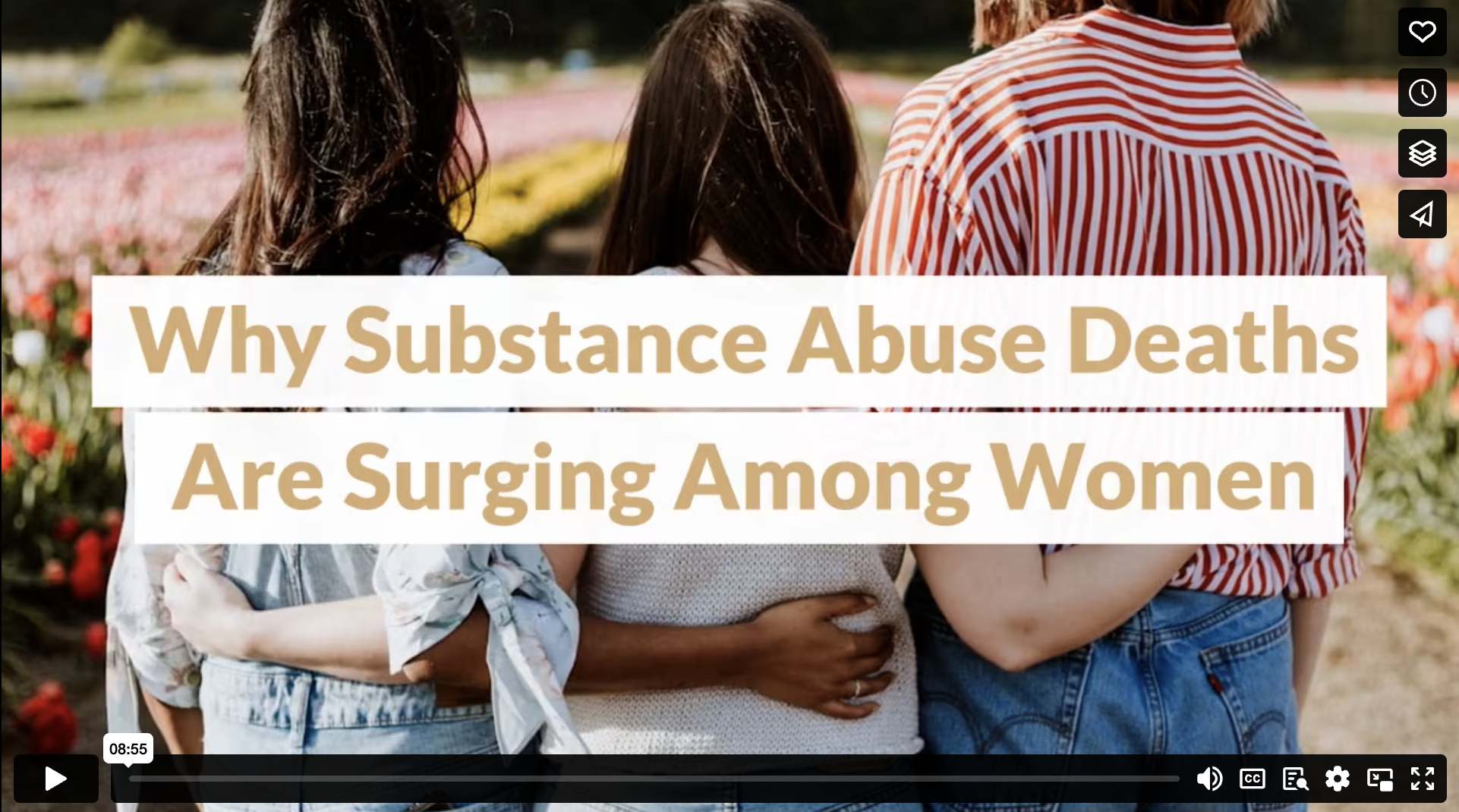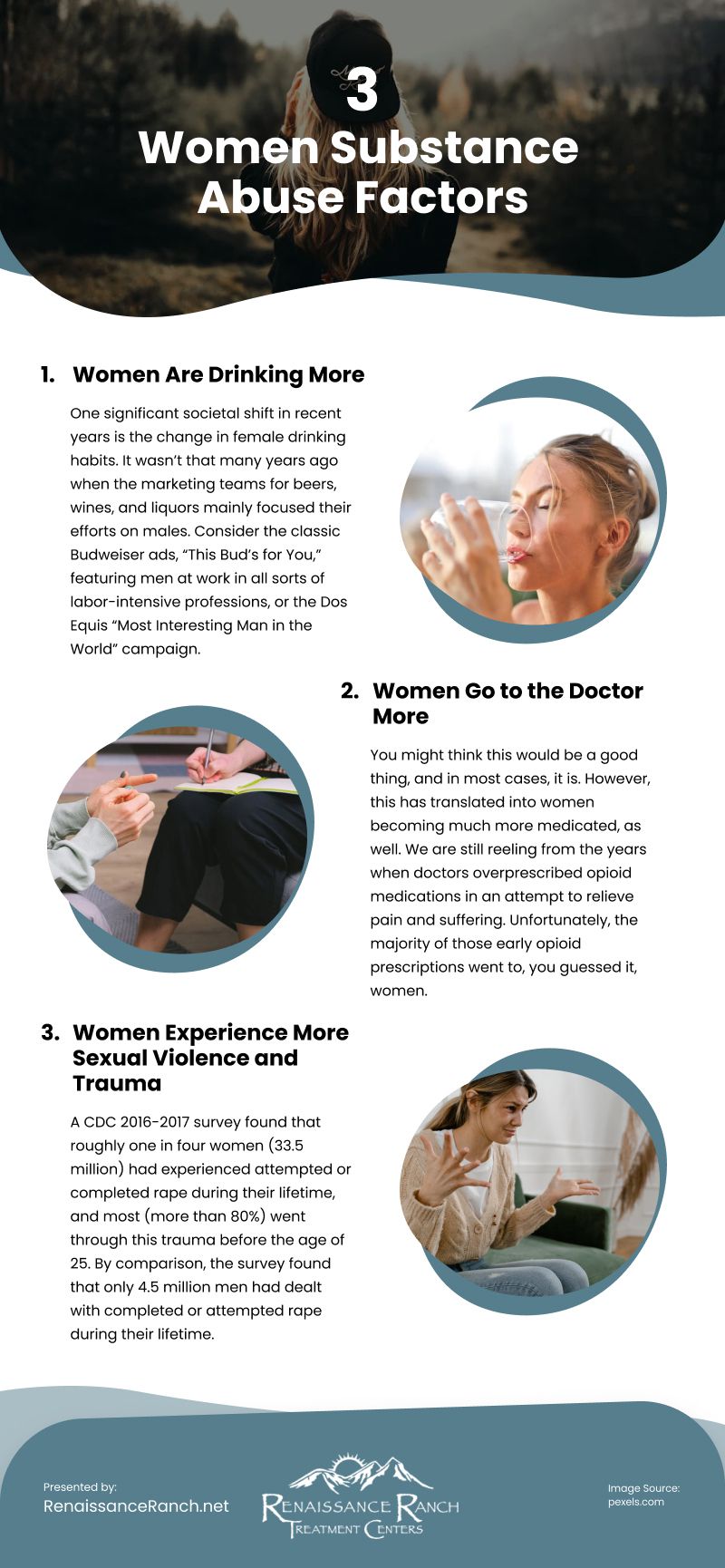You may have read in the news this past summer that women outpaced men in the growing number of alcohol-related deaths. Unfortunately, this trend represents only the tip of the iceberg in terms of increasing levels of substance abuse in the female population.
The Centers for Disease Control and Prevention conducted a multi-year study on the trends in alcohol-related deaths by gender from 1999 to 2020. While men continue to be nearly three times as likely to die in an alcohol-related incident, women are catching up at an alarming rate. For example, in the early 2010s, female deaths linked to alcohol use rose by 4.3%, just above a 3% increase in males. From 2018 to 2020, however, alcohol deaths among females rose by 14.7% compared to a growth rate of 12.5% for males during the same period.
In terms of drug overdose deaths, the CDC also found that women ages 30 to 64 experienced an astonishing 260% increase from 1999 to 2017. Researchers saw spikes in nearly all drug categories, including prescription and synthetic opioids, antidepressants, benzodiazepines, heroin, and cocaine.
These startling statistics leave us with a few questions: One, why? And two, what can we – as concerned loved ones or addiction recovery center professionals – do about it?

(MART PRODUCTION/Pexels)
Possible Explanations for the Increase
Only in the last few decades or so have medical professionals put more emphasis on finding out the reasons behind gender-specific substance abuse issues and how to treat them. Men and women not only have physiological differences that affect their propensity toward addiction, but they often have to deal with distinct social and emotional pressures related primarily to their gender.
Women Are Drinking More
One significant societal shift in recent years is the change in female drinking habits. It wasn’t that many years ago when the marketing teams for beers, wines, and liquors mainly focused their efforts on males. Consider the classic Budweiser ads, “This Bud’s for You,” featuring men at work in all sorts of labor-intensive professions, or the Dos Equis “Most Interesting Man in the World” campaign.
Fast-forward to today’s alcohol ads, which are aimed as much at women as they are men, e.g., Johnny Walker’s “First Strides” campaign that mixes strong women’s empowerment messages with a nice glass of whiskey. In addition to crafty marketers, social media has exploded with alcohol messaging targeted toward women, such as the proliferation of the trendy “mommy wine culture” and influencer lifestyles that reflect virtually non-stop individual and social drinking.
Kate Baily, a British podcaster and author, said in a 2022 interview with the BBC (British Broadcasting Corporation) that she’s concerned about the normalization of heavy drinking in adult women. “Feminized marketing popularized concepts like ‘mummy juice’ and ‘wine o’clock,’ linking them to how busy women navigated anxiety.” The danger with that, she added, is that “women [are] using alcohol [as] an acceptable face of self-medication and stress release.”
Finally, alcohol metabolizes less efficiently in women than in men, so a woman can have fewer drinks and yet get drunk faster. Females are also more susceptible to the adverse physical and mental health effects of alcohol, e.g., liver disease, cancers, alcohol use disorder, etc., with lower levels of exposure. What that boils down to is that women have put themselves considerably more at risk by trying to keep pace or surpass men in alcohol consumption. And popular media is only exacerbating the problem.
Women Go to the Doctor More
You might think this would be a good thing, and in most cases, it is. However, this has translated into women becoming much more medicated, as well. We are still reeling from the years when doctors overprescribed opioid medications in an attempt to relieve pain and suffering.
Unfortunately, the majority of those early opioid prescriptions went to, you guessed it, women. To make matters worse, CDC researchers found that women were more prone to use opioid pain relievers chronically and to ask for and receive them in higher doses.
Similarly, Indiana University scholars report that anxiety disorders manifest themselves in women twice as often as men, and thus, women have higher rates of access to prescription benzodiazepines. Coupled with the rise in alcohol use among women and a continued lack in adequate prescription monitoring, these substances in combination have proved fatal in far too many cases.
Women Experience More Sexual Violence and Trauma
A CDC 2016-2017 survey found that roughly one in four women (33.5 million) had experienced attempted or completed rape during their lifetime, and most (more than 80%) went through this trauma before the age of 25. By comparison, the survey found that only 4.5 million men had dealt with completed or attempted rape during their lifetime.
The CDC’s 2021 Youth Risk Behavior Summary & Trends Report further supports the premise that the rate of sexual violence against women is going up, reporting that the percentage of female high school students forced to have sex had increased from 12% in 2011 to 14% in 2021. In addition, the rate of female students who had experienced sexual violence by anyone rose from 15% in 2017 to 18% in 2021.
About 70% of sexual violence victims endure severe to moderate stress for days, months, and even years after the incident, more so than the victims of any other violent crime, according to the Rape, Abuse & Incest National Network (RAINN).
Other statistical data shows that compared to non-victimized women, sexual assault survivors are:
- Four times more likely to have considered suicide and 13 times more likely to have attempted it.
- 13 times more likely to have major alcohol issues.
- 26 times more likely to experience significant drug abuse issues.
What We Can (and Must) Do
As dire as these statistics are, we are not helpless in the face of this growing substance abuse crisis among women. There is much we can do.
Promote a More Sober Social Culture (for Both Genders)
Society has sold us on the idea that everything we enjoy—celebrations, dining out, sporting events, even work gatherings—must include alcohol. The general idea being that you can’t do anything fun without a libation in your hand. On the other end of the spectrum, popular culture also tells us that alcohol and drugs are your best friends when you’re stressed, tired, or down.
If you want to see a more sober-friendly society, you need to change the paradigm. For example, if you’re planning a wedding, maybe limit the liquor selection and offer more mocktails. Or skip the alcohol completely and have a soda bar. You can also help promote the “sober clubbing” scene by going out with friends to a sober bar or dance party. They will be able to see first-hand that they can have a great time without drinking shots or toking up and you’ll feel less pressure to use when you’re around them.
At the end of a rough day, instead of reaching for that glass of wine, go for a walk or bike ride. While you’re out there, you can post something positive like, “Loving the fresh air – Great way to unwind!” All great movements start with a single person—be the one who celebrates sobriety instead of being embarrassed by it.
Offer Comprehensive Care that Focuses on Women’s Needs
“Like men, women need specialized, coordinated substance abuse care that will meet them where they’re at,” said Preston Dixon, COO at Renaissance Ranch, an all-male substance abuse facility in Vernal, Utah. Although women usually seek help more readily than men, the stress of juggling work, child care, and other family responsibilities with treatment is generally too much, and they drop out of rehab prematurely. Without the proper support, relapse is just a matter of time.
“This is why we have opened The Refuge, a residential treatment center exclusively for women in Heyland, Idaho.” Dixon continued, “A woman’s substance use disorder (SUD) is often wrapped around major trauma issues, such as physical or sexual abuse. This means family support may look different than it does for men since, in some cases, the partner or spouse could be the one perpetuating the trauma or encouraging the drug and alcohol use.”
In addition, treatment goals differ between genders because women are often the primary caregivers for their children. In many cases, the kids have been put into foster care or placed with a relative until mom gets back on her feet. The shame many women feel about their addiction pales to the guilt they endure for being the reason for their children’s displacement. Regaining custody of and being able to take care of their kids represents a strong motivator for women in recovery.
“The Refuge offers a 60-day inpatient stay and an 8-month outpatient plan where the patient goes home or stays in our sober living facility in Burley,” Dixon explained. “In that time, we work to provide a full spectrum of care that includes detox and medical treatment, our faith-based 12-step recovery program, mental health and trauma therapy, medication management, and individual and group activities that heal and lift.”
The Ranch’s women’s program also provides the opportunity to participate in Sober Sisters, an after-care alumni group similar to the all-male Band of Brothers at Renaissance. “Sober Sisters allows women to maintain the connections they made in treatment. It’s crucial to travel this road with friends who understand what you’re going through and keep you accountable,” added Dixon.
For more information on our new women’s program, call us at 855-736-7262
Video

Infographic
Medical experts are now focusing on the unique substance abuse challenges faced by men and women, acknowledging their different physiological responses and social pressures. Women are experiencing a growing number of alcohol-related deaths, indicating a larger problem of increasing substance abuse. Find out in this infographic why there has been a surge in substance abuse deaths among women.

